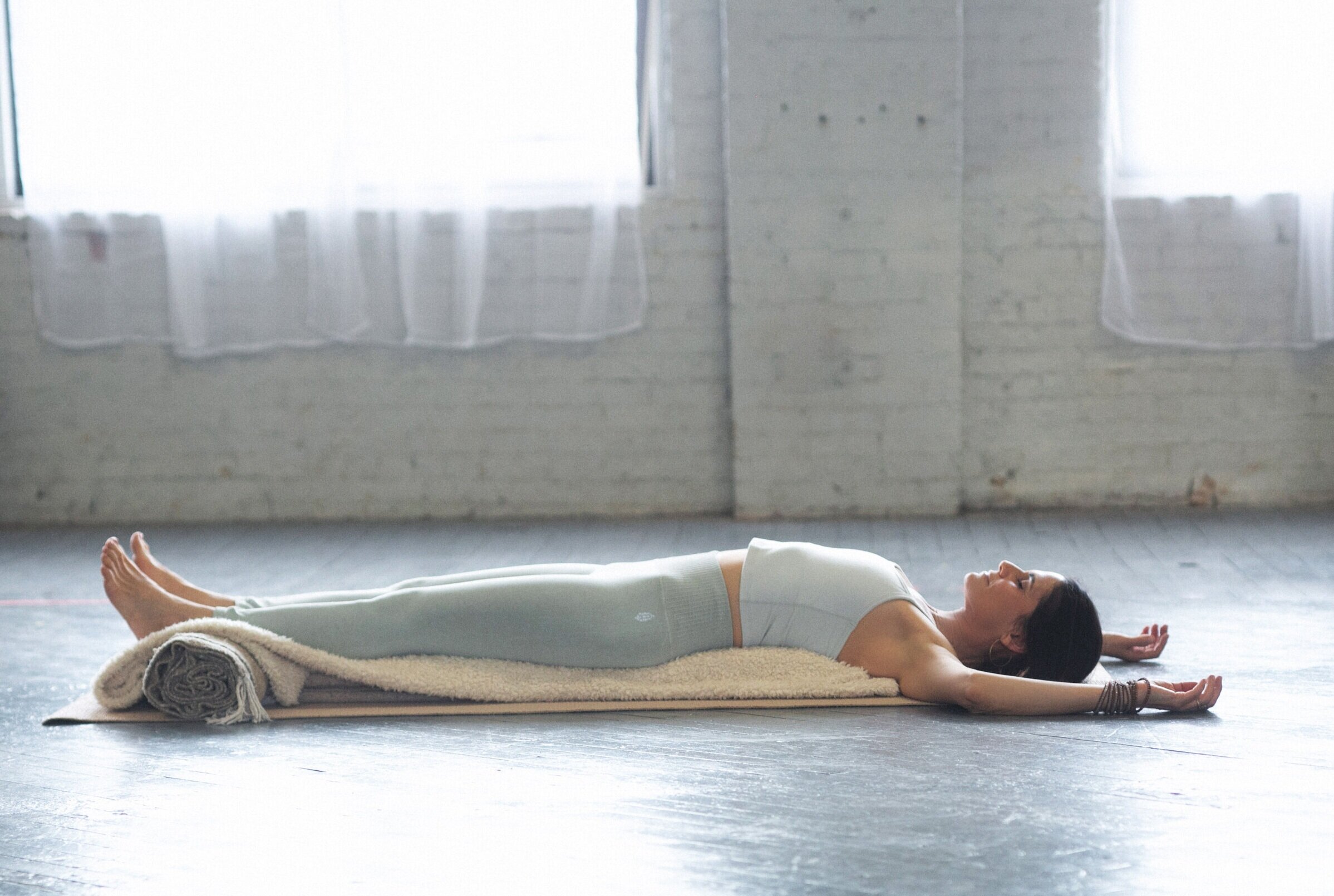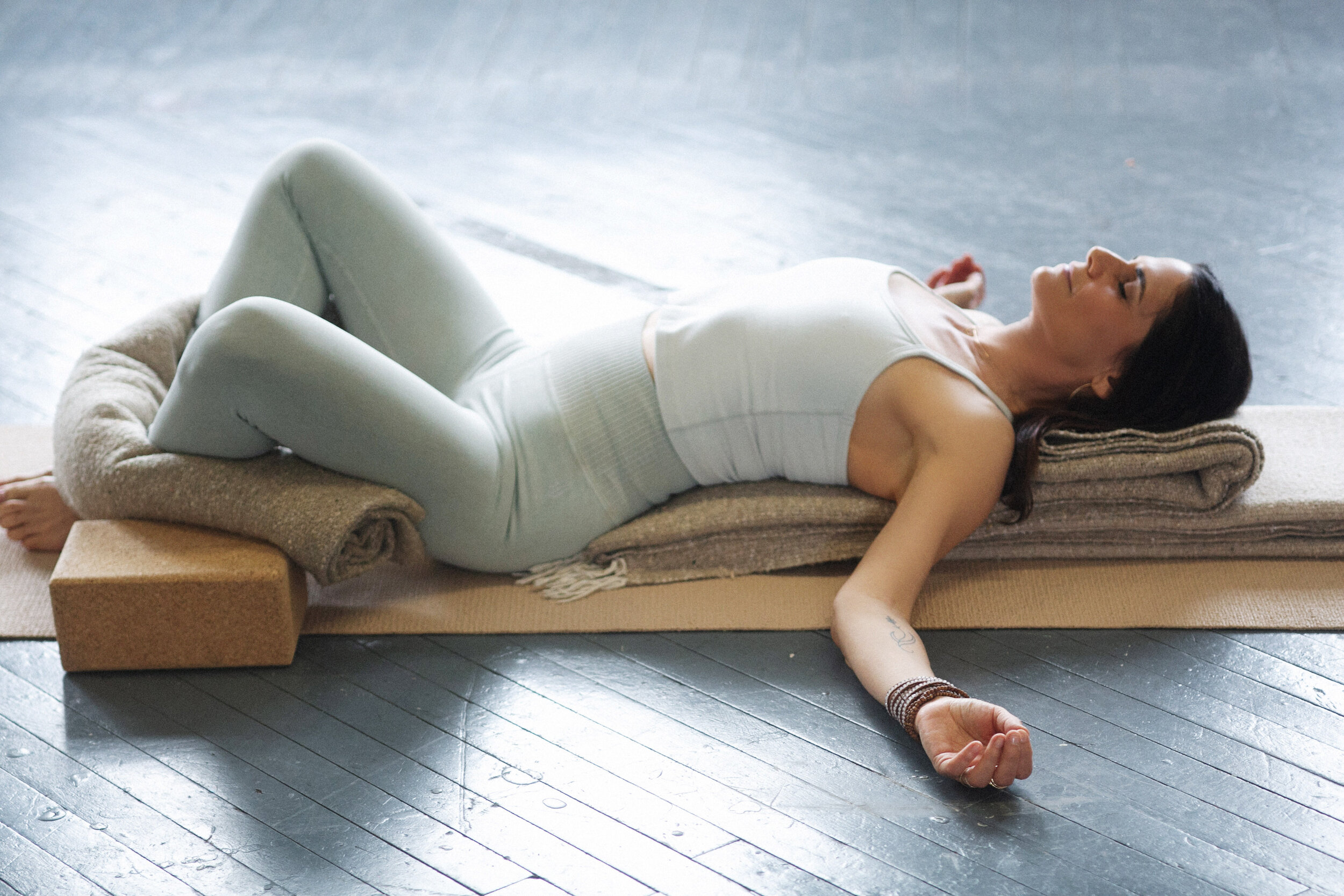
what is restorative yoga?
practices to calm, clear, and feel more connected
Tension is who you think you should be.
Relaxation is who you are.
—Chinese proverb
Take a moment to close your eyes and scan your body. Let your awareness slide through your face, your jaw, your neck, and land on your shoulders. What do you notice there?
Many of us experience a feeling of tightness around the neck/shoulder/back area, the backs of the legs, as well as other places in the body. It’s why we go to yoga—to stretch and “open” those tight spots. But the feeling of tightness isn’t always what it seems to be; it is often an expression of tension, a deeply-held stress response we carry around in our bodies.
Living in a stressed, tense, not-okay body is like showing up to a party in clothes that are all two sizes too small. Even if all your favorite people, foods, and music were at the party, you wouldn’t feel comfortable—you wouldn’t be able to breathe. When we allow our breath to flow freely and release physical tension, it’s like we’ve put on clothes that fit—maybe even have a little room. Replacing our armor of tension with the outfit of relaxation, we can enjoy ourselves and be present for the party. And that party is our lives.
FREE practice: 10 minute goddess pose
Restorative Goddess pose offers the opportunity to meet and melt our tension and habitual holding and nourish the chest and abdomen.
begin by pausing
Restorative yoga is different from other yoga practices, like vinyasa, hatha, or slow flow yoga, because it supports the relaxation response through passive, receptive, and largely still postures. Though there can be some movement before and within a pose, it is most similar to Yin yoga or even meditation. In restorative yoga we learn to relax all muscular effort, allow our body to land on the earth completely and our breath to flow freely. Then, if we find that we are still holding ourselves up somewhere, we relax all over again . . and again. . . . and again . . .
Little by little, you start to create more space in those places that are holding tension, putting awareness on them so they begin to change or loosen in ways they haven’t for months or years. But, because we’re so used to holding ourselves together, creating solidity in ways that make us feel safe, that when we first start to let go, we begin to feel anxious and uncomfortable.
Taking a slow, gentle approach to your body, your mind, and your life may feel awkward at first. This may not be something you are used to, so it may require a small leap of faith on your part to believe that it will be worthwhile. It will.
I say this because restorative yoga is often thought of as the “yummy,” “juicy,” or even “easy” form of yoga. It is all those things, but it is also hard work. It takes dedication and practice to release tension and peel back the layers of protection our nervous system built for us. In order to start that brave process, though, we need to pause, on purpose, to gather ourselves. This is what the restorative practice offers us: an opportunity to pause.
I believe restorative is one of yoga's most advanced practices.
When we pause, we take a moment to be with ourselves, right here, right now, in whatever state we’re in. We don’t have to do anything. We don’t have to feel any particular way.
Pausing gives us extra room to take things in. It allows us time to listen to ourselves before responding or reacting. We pause so we can pay attention to ourselves, to others, and to the world around us in a more open and compassionate way. It’s one of the main tools we use to release tension in our bodies and in our minds. It’s one of the most valuable skills we have to change habits that do not serve us.
releasing in to the ground
We often think of being grounded as a mental state, but our minds and bodies are wholly interconnected. As our minds fritter away, our bodies follow—keeping us disconnected from the present moment. Frenzied, holding it all together, constricted, holding ourselves up . . . it is easy to forget there is actually ground underneath us, holding us up. That there is a support that is always there.
As we welcome our breath into our body, and our bodies onto the earth, we create conditions to show up more, in the present—where we can access our own resilience and resources.
Let your body land on the ground
Let your breath arrive in your body
let your mind rest on your breath
Welcome your whole self, here, now.
We are learning to allow the ground to carry us.
We are learning to allow our body to be on the earth.
You don't have to hold everything up.
Let the earth hold you up.
The earth is welcoming you. Longing to hold you.
Welcome yourself fully, just as you are here now.

meet me on the mat
What are the benefits of restorative yoga?
We can all benefit from releasing the unnecessary habitual tension from our body and mind, and restorative yoga can be an essential antidote for our fast-paced, stressed-out lives. However, allowing ourselves time to slow down, rest, and grow quiet and still, is most often not easy. But even a small taste, a tiny glimpse, of the profound benefits of restorative can help to draw people deeper into this life-changing practice.
Here are 4 BIG BENEFITS of restorative yoga and insight into why it is an advanced practice:
-
1.
Restorative yoga helps us cultivate the skill of conscious relaxation. Restorative yoga uses long-held, supported resting poses to create the conditions for us to release unnecessary habitual tension in the body and mind. For many of us, yoga practices can easily become another opportunity to over-effort or get caught up in accomplishing a pose. Restorative yoga is about, "How can I let my body and mind unwind? How can I do less?"
-
2.
Restorative yoga helps us discover where we are holding tension. The actual effort involved in restorative yoga is the willingness to look at how and where we are holding tension, and to relax our body on the ground, allowing the breath to come in more, so the tension that we find can be softened or less gripping.
-
3.
Restorative yoga creates the conditions for the relaxation response to kick in. The grounding; complete, full breathing; and quietness of restorative yoga help us elicit the relaxation response, a neurological response that tells us we are safe, pulls us out of "flight or fight" mode and initiates the body's self-healing process. This bolsters the systems of long-term health and healing, including digestion, elimination, reproduction, growth and repair, and immunity.
-
4.
Restorative yoga helps us face what we are avoiding about ourselves. Our habit of running around, conquering our to-do lists, and fueling ourselves with coffee and ambition can often be a way we avoid deep discomforts and unwelcome feelings in the body and mind. Restorative yoga asks us to stop engaging in all the doing and face what we really need to look at about ourselves.

suggested reading
If you want to learn more about the neuroscience of stress and relaxation, and how restorative yoga has been documented to reduce the stress response, you might enjoy the following resources:
Yoga as Medicine by Dr. Timothy McCall
Anxiety and Depression Association of America—stress statistics and resources
Mental health before and during the COVID-19 pandemic: a longitudinal probability sample survey of the UK population
The Lazar Lab for Meditation Research at Massachusetts General Hospital
Boston University Medical Center (March 2012)
Boston University School of Medicine (November 2019)
NYU Langone Health / NYU School of Medicine (August 2020)

